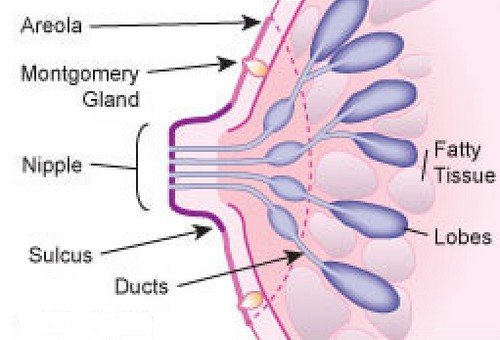The Montgomery gland is a large sebaceous gland in the breast. It represents the transition between the sweat gland and the mammary gland. It was named after an Irish obstetrician, William F. Montgomery.
It is situated in the areola and it secretes oily fluid, which lubricates and protects the nipple. The part of the gland that can be seen on the skin’s surface is called Montgomery tubercles. They are round bumps in the areola.
A few of them can be found on the nipples too. The tubercles lubricate the breast during breast feeding. They also help fight infection. If the nipple is stimulated, the Montgomery tubercles are raised and become prominent. During pregnancy, the Montgomery tubercle becomes prominent. Montgomery glands are also found in the areola (a small circular pigmented area surrounding the nipple). (1, 2, 4, 5)
Prominent Montgomery tubercles are presumptive sign of pregnancy. Other factors that can affect the appearance of Montgomery tubercles include the following:
- It can be brought by physical changes in the body other than pregnancy.
- Stress is one of the factors that can directly affect the appearance of Montgomery tubercle.
- Hormonal imbalance could lead to prominent bumps in the areola. Too much stress, pregnancy, and anxiety are some of the situations and conditions causing hormone imbalance.
If you are trying to get pregnant or suspecting that you are pregnant, you should stand in front of the mirror and check your Montgomery tubercle. If they are prominent, then most likely it is a presumptive sign of pregnancy. To confirm the diagnosis, you should immediately conduct a pregnancy test. If you are not pregnant, but still the Montgomery tubercle is prominent and you see a discharge, you should immediately see your health care provider. This could suggests an underlying medical condition. (2, 3, 4)

Image 1 : A simplified anatomy of the breast
Picture Source: www.women-info.com
What are the functions of Montgomery gland?
- It keeps the nipple and the areola lubricated. The breasts are made up of sensitive tissues. They can easily get dried and irritated. Hence, it is important to keep them moist. Montgomery gland prevents breast irritation by secreting oily substance. The secretion also prevents the entry of foreign objects in the nipple tip.
- The secretion of Montgomery gland acts as olfactory stimulus for the baby. The baby will find his way to the nipple during breastfeeding. The sucking motion of the baby may lead to drying and cracking of the nipple. With the secretion of Montgomery gland, dryness and cracking will be prevented.
- The oily fluid produced by the Montgomery gland has antimicrobial property, which prevents the growth of germs. (5, 6, 7)
Increase number of Montgomery gland during pregnancy
During pregnancy, a lot of changes in the body happens. The breast, especially the nipples are getting ready for mild production. The Montgomery gland is enlarged, which means that your body is preparing for pumping of milk for your baby.
Changes in the Montgomery gland become prominent in the second trimester of pregnancy. As the gland increases in size, the fatty tissues in the breast get bigger too. This is the reason your breasts are enlarged during pregnancy. The breasts can grow four times bigger than their normal size. The Montgomery gland gradually produces oily secretion, which lubricates and protects the nipples and the areola. The areola is highly pigmented, but during pregnancy it gets darker and bigger. (7)
Montgomery gland infection
Montgomery gland, being on the surface of the breast makes it susceptible to infection. Some women complained that their nipples and the area surrounding it becomes itchy, painful, tender, and swollen. This type of infection is usually associated with mastitis. It does not only involve the Montgomery gland, but as well the entire mammary gland and the surrounding tissues. It is common in lactating women.
A Montgomery gland cyst (retroareolar cyst) is also possible, although it is a rare condition. It starts with an acute inflammation of the gland along with nipple discharge (clear, light to brownish fluid). It usually subsides on its own, but could lead to the development of subareolar mass.
The condition is usually asymptomatic. When a young women (10-20 years old) complains of pain in the breast area along with palpable breast nodule, it warrants immediate medical attention.
Various diagnostic procedures should be carried out to accurately diagnose the condition of the patient. An ultrasonography will show the presence of cyst in the retroaerolar area. The condition can be very painful and could bring discomfort to the patient.
The clinical management centers on the symptomatic relief. If the patient does not show any signs of infection, then most likely the cyst will disappear on its own. It may take a few months to two years. A repeat ultrasound should be made to detect the presence of cyst.
On the other hand, if the patient showed infection such as pain, tenderness, redness, and warmth, treatment should be given immediately. The treatment approach is usually a combination of various drugs such as non-steroidal anti-inflammatory drugs and antibiotics.
The inflammation will gradually disappear. In some instances, a drainage of the cyst is required. If the cyst persists, a resection of the Montgomery will be made. (8, 9, 10)
Taking care of Montgomery gland
- Keep your breast clean at all times, especially the nipples and the areola. You can use a towel or gauze to thoroughly yet gently clean the breast.
- If there is dirt that is difficult to remove, you should put lubricant such as olive oil. Wait for a few minutes and you will notice that the dirt softens.
- Wash your breast with warm water using gentle soap.
- Avoid putting anything on your breast, especially products containing harmful ingredients. Keep in mind that the Montgomery gland is highly sensitive. Too strong products could cause drying and cracking.
- Avoid putting nipple cream or ointment unless prescribed by your doctor.
- Leave the Montgomery gland alone as long as the breast, nipples, and areola are healthy. (4, 5, 7, 10)
References:
- www.verywell.com
- http://www.medhelp.org
- www.bellybelly.com.au
- www.whattoexpect.com
- en.wikipedia.org
- www.healthtap.com
- www.modernmom.com
- https://medlineplus.gov
- ehealthhall.com
- www.rightdiagnosis.com



